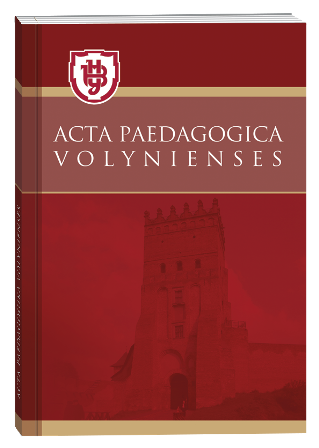LINGUODIDACTIC FRAMEWORK OF ASSOCIATIVE TEACHING FOREIGN LANGUAGES TO STUDENTS OF PRIMARY EDUCATION
DOI:
https://doi.org/10.32782/apv/2023.5.5Keywords:
associative teaching, foreign languages, personal qualities, intensive training strategy, the method of graphic associations, rhythmization, students, primary educationAbstract
The purpose of the article is to analyze linguodidactic peculiarities of associative teaching foreign languages to students of primary education. Methods of the research. The following theoretical methods were used to solve the tasks formulated in the article: the method of the analysis, structural and functional method, systematization, generalization. The result of the research. In the content of associative teaching foreign languages to students of primary education we can emphasize the ability to optimize learning foreign languages by students of primary education. A few basic concepts of teaching foreign languages theory, which are important for associative learning and teaching foreign languages to students of primary education, are considered in the article. Speaking of modern teaching technologies at primary school, which are focused on the psychological characteristics of young learners and activation of their reserves, we cannot but mention the intensive methods of teaching, which form the core of associative learning strategy. The purpose of intensive associative learning is to assimilate maximum amount of educational material in a minimum period of studies. Associative learning strategy in its various aspects is realized in view of the individual characteristics of every pupil and taking into account the individual psychological differences in mastering a foreign language. Individual style of associative learning of a foreign language is caused by the presence of certain capabilities and skills. Associative learning strategy provides such a possibility to actualize all kinds of learner’s individual qualities in harmony. We study native language via life experience without any effort, since a child stays in an environment of native language from his very birth, which contributes to the speedy and effective absorption of a language. In accordance with the principles of associative learning a child must be taught a foreign language in the same way in which he assimilated the native language (Hunko, 2010). Conclusions. Having analyzed the linguodidactic peculiarities of associative teaching foreign languages to students of primary education we came to conclusion that associative learning strategy in general is focused on modern innovative technologies of training. It meets new goals and tasks of teaching foreign languages at primary school observing the age and individual characteristics of young learners and their needs, among which the basic ones are: the need to play games (through game-playing activity the content of educational material is better absorbed), the need to move, the need for external impressions, cognitive needs.
References
Бідюк І. Психологічні основи навчання іноземної мови в початковій школі. Психологічна газета. 2004. № 20. С. 24–31.
Блавацька І. Є. Теоретичний аналіз проблеми визначення поняття психолінгвістичних здібностей до опанування іноземної мови. Наука і освіта : наук.-практ. журнал. 2008. № 8–9. С. 18–23.
Гунько, С. В. Метод асоціативних символів – сучасний високоефективний метод вивчення іноземної мови на початковому етапі. Наук. вісн. Волин. нац. ун-ту ім. Лесі Українки. Філологічні науки : Мовознавство. 2010. № 8. С. 319–329.
Інноваційні технології навчання учнів початкових класів : монографія / Гусак П. та ін. Луцьк : Вежа-Друк, 2016. 276 с.
Кравець В. Педагогічна система Яна Амоса Коменського. Історія класичної зарубіжної педагогіки та шкільництва : навч. посіб. для студ. пед. навч. докл. Тернопіль, 1996. С. 122–178.
Лозова О. М. Психологічні аспекти засвоєння іноземної мови : навч. посіб. Київ, 2010. 143 с.
Митник, М. Зіставний аналіз існуючих інтенсивних методів навчання іноземних мов. Наукові записки. Серія : Педагогіка. 2016. № 4. С. 210–216.
Мордоус І. О., Куценко І. М. До питання про використання педагогічних технологій у роботі з навчання дітей молодшого дошкільного віку іноземної мови. Освітній дискурс = Educational discourse : зб. наук. пр. / Нац. пед. ун-т ім. М. П. Драгоманова. Київ, 2018. C. 53–65.
Bachler R, Segovia-Lagos P and Porras C. The role of emotions in educational processes: the conceptions of teacher educators. Front. Psychol. 14:1145294. 2023. doi: 10.3389/fpsyg.2023.1145294
Butzkamm, W., Butzkamm, J. Wie Kinder sprechen lernen. Kindliche Entwicklung und die Sprachlichkeit des Menschen. Tübingen; Basel : Francke, A. 1999. 404 p.
Chernovatii, L. Processes of translation and interpreting from a native into a foreign language: Psycholinguistic aspects. Psycholinguistics. 27(2). 2020. 344–360. DOI: 10.31470/2309-1797-2020-27-2-344-360 (Scopus, Web of Science) (co-author Kovalchuk N.).
Chomsky, N. Rules and representations. N. Y. : Columbia University Press. 1980. 299 p.
Darici, N. Suggestopedia: an effective way to teach and learn a foreign language. ScienceRise, (3). 2022. 67–72. https://doi.org/10.21303/2313-8416.2022.002565
Peltzer-Karpf, A., Zanglе, R. Die Dynamik des frühen Fremdsprachenerwerbs. Tübingen : Narr. 1998. 187 p.
Seligson, P. An Introduction to Teaching English to Children. Susan House, Richmond Publishing. 1997. 96 p.







